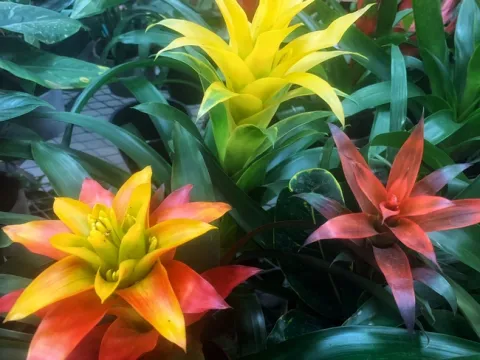
Bromeliad
By Deborah Light-Pacheco UCCE Master Gardener
Common name of plant: Bromeliad
Scientific name: Bromeliaceae
Planting area: Sunset 13, 19-24, H1, H2
Size: Depends on species
Bloom Season: One bloom
Exposure: Bright, indirect light
Pruning needs: n/a
Water needs: Regular
Snapshot: If you are looking to create a tropical feel to your indoors, Bromeliad is the plant for you! Bromeliads are a member of the Bromeliaceae family. Quirky fact: this is the same family as pineapples and Spanish moss. The leaves are leathery, and they produce a gorgeous, colorful spiked flower in shades of pink, orange or yellow. These are slow growing perennials with thousands of varieties, some of which are air plants, grown outdoors clinging to trees. However, most Bromeliads available to the public are cultivated for indoor use.
Bromeliads are typically sold when in bloom. Blooming requires very specific conditions which differ based on species. If you purchase a plant without a bloom, find out the specific genus and species to determine the best growing conditions.
To flourish, Bromeliads need a well-draining potting soil with some sand. Orchid mixes work well. Water by moistening the soil or by filling the center depression or the “cup” formed by the rosette of leaves. Keep the soil moist, but not soggy as these plants are susceptible to root rot. If watering the cup, be sure to flush the cup to prevent salt build up. Different species require different amounts of light. Some plants can take a full tropical sun while others are less tolerant and need indirect light. If the main leaves are yellowing, it's getting too much light. If they are darkening, it's getting too little light. Temperatures should be between 60-85 degrees Fahrenheit with some humidity, keeping in mind, these are tropical plants.
Bromeliads are largely pest free, but aphids, mealybugs and scale may occur. Carefully inspect your plants for signs of insects or disease before you purchase. Pull the plant from its container to inspect the roots as well. It's best to purchase clean plants to avoid unwelcome surprises. When you select a clean plant and take it home, wash the leaves with water and a clean towel to remove any debris or hidden pests. Monitor for pests by inspecting the leaves regularly and wash off any insects with water to prevent further development.
Bromeliads live for 2-5 years and bloom once. The mother plant then slowly dies using its final energy to produce new plants called pups. The bloom lasts up to 6 months so you will have a beautiful Dr. Seuss-like bloom to enjoy for months!
Our Advice to Grow By Workshops are back!!!
Our next workshop will be January 21st, 2023, at 10:00 to 12:00 p.m. in our Seven Sisters Demonstration Garden at 2154 Sierra Way, San Luis Obispo. The topic will be “Fruit Trees: How Winter Care Can Aid Warm Weather Success”.
Learn why the winter season is so important to the development of deciduous fruit trees. You'll learn how to select and plant bare root trees, how to arm yourself for dealing with pests and disease, and how winter is an important time to perform maintenance on mature trees along with a pruning demonstration. There will also be a discussion of winter care of citrus trees. This workshop will be held in our garden so please be prepared for the weather outside. Inclement weather will cancel the workshop.
Other ways to see or reach us:
You can view workshops on Instagram live at slo mg or visit our You Tube channel at “San Luis Obispo County UC Master Gardeners.”
Visit our website at ucanr.edu/sites/mgslo/ or email questions to anrmgslo@ucanr.edu.
Our physical offices are now open!!!!!
Covid may still affect staffing levels, so it is best to call before heading to your local Helpline office:
San Luis Obispo: 805-781-5939 (Monday and Thursday 1:00 to 5:00)
Arroyo Grande: 805-473-7190 (10:00 to 12:00)
Templeton: 805-434-4105 (Wednesday 9:00 to 12:00)

